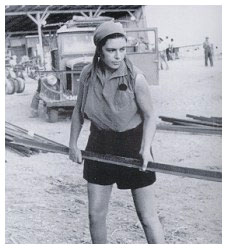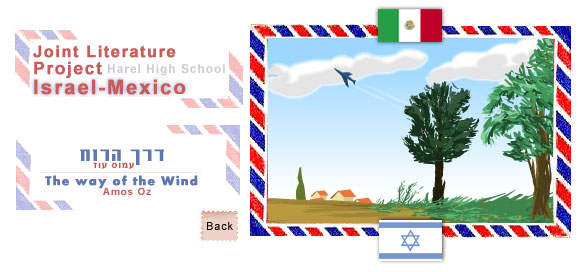| |
|
|
The Kibbutz Artzi is a
federation comprising 85 kibbutzim founded by the Hashomer Hatzair youth
movement. In 1998 it numbered around 20,000 members and its entire
population (including children, candidates, parents of members etc.)
totaled approximately 35,000.

The History of
Hashomer Hatzair and The Kibbutz Artzi Federation
Hashomer Hatzair, the initial Zionist youth movement, was founded in
Eastern Europe on the eve of the First World War. Many Jewish youth,
affected by the process of modernization which had begun among Eastern
European Jewry, sought a means of maintaining their Jewish identity and
culture outside the stifling barriers of the shtetl and of Orthodox Jewish
life. On the other hand, they were troubled by the crumbling of the
foundations of society around them and by the growing antisemitism which
threatened their very existence. In its early stages the movement was
heavily influenced by the Scout Movement organized by Baden-Powell and it
embraced scouting as a basic principle to teach ghetto youth
self-reliance, outdoor life and a love and knowledge of nature. Another
important influence upon them was the Wanderfoegel movement in Germany,
which emphasized youth's independence and creativity.

Hashomer Hatzair forthwith adopted a Zionist ideology and stressed the
need for the Jewish people to normalize their lives by changing their
economic structure (as merchants) and to become workers and farmers, who
would settle in the Land of Israel and work the land as "chalutzim"
(pioneers). They were influenced, as well, by the burgeoning socialist
movement, and they dreamt of creating in their new homeland a society
based on social justice and equality.
The first members of the movement went to settle in Palestine in 1919,
immediately after the war. There they found not "a land of milk and
honey", but rather a barren, impoverished, undeveloped country lacking all
means to maintain them. "If you will it, it is no legend" Theodore Herzl
had said. They had the will, and a movement behind them, so they found the
way. No one could build the land for them, therefore they had to do it on
their own. Individually it could not be done, so they banded together and
formed kibbutzim, collective settlements. The idea evolved naturally as a
result of the conditions they found in Palestine. A few kibbutzim were
already in existence when they arrived, particularly Degania, the first
kibbutz, in the Jordan Valley.
In 1927, the kibbutzim of Hashomer Hatzair, until then individual and
separate settlements, decided to join together for greater mutual aid and
to provide a focus for the world organization. The federation was named
the Kibbutz Artzi. The movement's goals became clearer and a pattern was
set for future development. At its inception the Kibbutz Artzi numbered
four kibbutzim, with 200 members. In the following years Hashomer Hatzair
spread throughout the Jewish world and its impact began to be felt in
Jewish communities everywhere. Adult members of the movement emigrated to
Palestine and formed new kibbutzim. In 1937 the very first kibbutz of
Americans was settled at Ein Hashofet, named in honor of Justice Louis
Brandeis, a warm supporter of Hashomer Hatzair. On the eve of the Second
World War, the Hashomer Hatzair youth movement numbered 70,000 members
world-wide.
In the spirit of the goals that the original founders had set for
themselves, the movement established schools, cultural facilities, a
publishing house and a daily newspaper, joint economic projects and
instruments for mutual help.
The years of the Holocaust brought catastrophe to the Jewish people, it
also destroyed the core of the Hashomer Hatzair movement in Europe, many
of whose members fell in activities against the German forces. Hashomer
Hatzair was active in leading resistance in the ghettoes, the forests and
the concentration camps. In the Warsaw ghetto, members of the movement
were among the organizers of the Jewish Fighting Organization, and a
member of Hashomer Hatzair, Mordechai Anilewicz, stood at its head. In
Hungary, Lithuania, Slovakia and elsewhere in Nazi-occupied Europe,
members of Hashomer Hatzair were to be found in the front ranks of the
Jewish and general resistance and in attempts to rescue Jews.
As the war ended and the remnants of European Jewry were freed from the
death camps, members of Hashomer Hatzair were among the first to organize
the "illegal" flight of the survivors across the borders of Europe and to
take part in the illegal immigration to Palestine, whose gates had been
barred by the British. The leader of the refugees aboard the famed illegal
immigration ship "Exodus" was a member of Hashomer Hatzair.
At the same time Hashomer Hatzair was active in the Haganah, the
underground army of the Jewish community in Palestine. Together with the
other kibbutz federations, its members formed the nucleus of the Palmach,
which served as the shock troops in the war for Israel's independence.
When the State of Israel was proclaimed on May 14, 1948 six Arab armies
attacked the new nation and tried to crush it still-born. The battles were
bitter. High in the annals of the struggle stand kibbutzim of the Kibbutz
Artzi which were settled along the borders of the new country and were
among the first to bear the brunt of the attack. Kibbutz Yad Mordechai
(named for the commander of the Warsaw Ghetto revolt) and Kibbutz Negba,
blocked the path of the Egyptian army to Tel Aviv. These and other
Hashomer Hatzair kibbutzim were in the forefront of the effort of the
entire Jewish community to win the final liberation of Israel.
The Kibbutz Artzi
Federation in the State of Israel
In the first years
of the new state the Kibbutz Artzi took an active role in settling new
kibbutzim. The kibbutzim played an important part in reclaiming the barren
lands, in absorbing new immigrants and in securing the borders of the
country. However many of the functions that had been fulfilled by the
kibbutz movement in the pre-independence period were now taken over by the
state. The central role that the kibbutz had played diminished and with it
the attraction of the kibbutz to young people.

In the course of time the kibbutzim grew and changed, in keeping with the
changing times and environment. The development was not always smooth, and
the movement often experienced periods of crisis as well as of prosperity.
During the 1960's and 70's the standard of living of the kibbutzim rose
immensely and they no longer needed to struggle to eke out a bare
existence. In this last decade, the Kibbutz Artzi, together with the
entire kibbutz movement, has been going through one of its most difficult
crises. The change of government in the late Seventies; the revision in
the direction of the national economy, which affected all the productive
areas of the economy; a delay in adjusting the internal organization and
administration of the kibbutz to the new conditions, all brought on
economic difficulties, and in its wake an undermining of confidence of
many of its members.
Today, on the eve of a new millenium, the Kibbutz Artzi is attempting to
deal with its distinctive path as a cooperative, humanistic society. It is
doing so by carrying out far-reaching changes in the structure and
activities of its economy; in its organization and administration; in
fostering culture and education; and in readjusting the democratic
structure of its society.
At the same time, the Kibbutz Artzi continues to maintain its educational
activities and the absorption of hundreds of youth from outside the
kibbutz, while continuing in its social and political activity. It also
takes part in the national task of absorbing new immigrants. The endeavor
to guarantee the future of the kibbutz is accompanied both by anxiety and
with much hope for the future, as well as with a belief in the ability of
the kibbutzim and the movement to renew themselves, and to continue to
develop humanistic and cooperative forms of life that will fit the needs
of the individual and of society in the future.
Facts and Figures
Agriculture (as of
1998): The kibbutzim of the Kibbutz Artzi own 209,000 acres of
agricultural land, of which 127,000 acres are under crops. These include:
11,000 acres of orchards; 59,000 acres of unirrigated field crops (wheat,
barley etc.); and 45,000 acres of irrigated crops (cotton, flowers etc.);
17,000 acres of vegetables and hothouses.

The kibbutzim also produce 175,000,000 liters of milk; 25,000 tons of
chicken; 10,000 tons of turkey; and more than 4,000 tons of fish per year.
Industry: In 1996 the total industrial production of the 121 factories of
the Kibbutz Artzi was $1,217,000 of which $446,000,000 went for exports.
The factories may be found in fields as diverse as plastics and rubber,
metal, food, paper, electrical appliances and electronics, chemicals and
pharmaceutics, furniture etc.
Services: In recent years many kibbutzim have entered the service
industries as a means of augmenting their incomes. These include Guest
Houses, Bed and Breakfast facilities, Hot Springs and Food Stores.
Outside income: A growing component of kibbutz income comes from the
salaries of kibbutz members who work outside the kibbutz in their
professional capacity, such as lecturers and teachers, health workers,
engineers and business managers.
|
|
|




